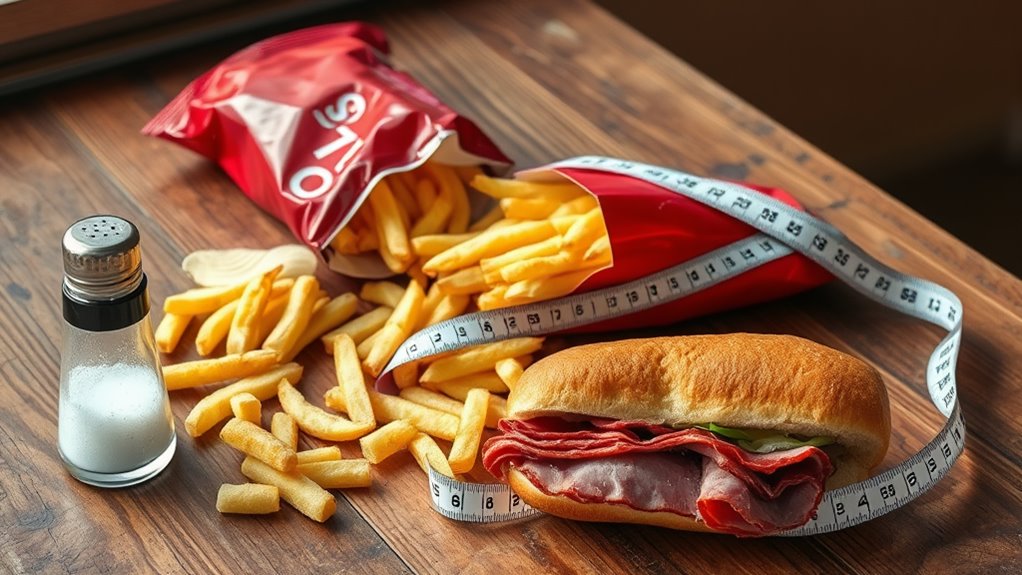If you're dreaming of a flat stomach, these common foods could be secretly sabotaging your goals.

To achieve a flatter stomach, you’ll need to avoid several key foods that contribute to bloating and belly fat. White bread and refined carbs can increase abdominal fat accumulation, while sugary processed foods disrupt gut health and cause inflammation. Dairy products, carbonated beverages, and high-sodium foods lead to bloating and water retention. Even some vegetables, particularly cruciferous ones, can cause stomach distension. Understanding these dietary culprits will help you make smarter choices for your waistline.
While white bread may be a diet staple for many people, research indicates it’s a significant contributor to belly fat accumulation. Studies show that consuming high amounts of refined carbohydrates leads to increased abdominal fat over a five-year period, primarily due to their impact on blood sugar and insulin levels.
The refining process strips grains of their nutrient-rich components, resulting in a product that’s low in fiber and high on the glycemic index. When you eat white bread, you’ll experience rapid blood sugar spikes followed by crashes, which can trigger overeating and promote fat storage around your midsection. Additionally, frequent consumption of refined carbs can cause chronic inflammation and leptin resistance, further contributing to obesity. People who consume 7-10 slices daily face a 33% higher risk of cardiovascular problems, making belly fat reduction even more critical for overall health.
To achieve a flatter stomach, you’ll want to replace white bread with whole grain alternatives. This simple change can help reduce your risk of metabolic dysfunction and improve your body composition.
You might be surprised to learn that many seemingly healthy foods contain hidden sugars that cause gut inflammation and bloating. Your body quickly absorbs these processed carbohydrates, leading to blood sugar spikes, increased insulin resistance, and eventual fat storage around your midsection. When you regularly consume ultra-processed foods, you’re disrupting your gut microbiota and creating conditions that make it harder to maintain a flat stomach. Even sugar-free alternatives can increase appetite and contribute to weight gain despite marketing claims of being healthier options.
Many processed foods harbor hidden sugars that greatly impact gut health and stomach appearance. Common culprits include breakfast cereals, flavored yogurts, and condiments, which often contain significant amounts of sugar despite their healthy appearance. These hidden sugars disrupt your gut microbiota balance, leading to inflammation and compromised intestinal barrier function. The American Heart Association recommends keeping added sugar intake under 25 grams per day for women and 36 grams per day for men.
When you consume excess sugar, your stomach experiences bloating, distress, and gas that can last up to 5 hours. Even products labeled “no added sugar” may contain high natural sugar content, affecting your gut’s ability to maintain proper immune function and nutrient absorption.
Beyond hidden sugars, processed carbohydrates represent another significant threat to achieving a flat stomach. When you consume refined carbs, they trigger rapid digestion and absorption, causing quick glucose spikes that lead to insulin resistance and inflammation. Your gut microbiota becomes disrupted, with an increase in Proteobacteria an. This disruption can cause complex carbohydrate intolerance, leading to uncomfortable gas and bloating from foods like refined grains and processed cereals.
You’ll find that dairy products rank among the most significant contributors to stomach bloating and gas, primarily due to their lactose content and high-fat composition. Common dairy items like cheese, ice cream, and milk can slow digestion and cause discomfort, especially if you consume them in large quantities or have lactose sensitivity. Beyond dairy, certain food groups including legumes, cruciferous vegetables, and fructose-rich fruits can trigger similar gas-producing effects through their complex sugars and fibers. To minimize digestive issues, consider replacing these items with alternatives like dark leafy greens which are more easily digested by most people.
While dairy products are a common source of essential nutrients, they can greatly contribute to stomach bloating and digestive discomfort for many individuals. Undigested lactose travels to the colon, where it ferments and disrupts the gut microbiome, leading to inflammation and increased gas production.
You’ll want to watch for these key impacts on your stomach:
Fermented dairy options like yogurt and kefir can be easier to digest and may help restore beneficial gut bacteria. Consider tracking your dairy intake through a food journal and exploring lactose-free alternatives to identify which products affect you most greatly.
Dairy products represent just one category among numerous food groups that can trigger stomach bloating and gas production. You’ll find that grains and starches, including wheat, corn, and potatoes, can cause significant gas due to their raffinose and fiber content. Common fruits and vegetables like beans, cabbage, broccoli, and apples contain gas-producing compounds such as sorbitol and fructose. Some low-gas alternatives include blueberries and kiwi, which provide essential nutrients without excessive bloating.
Sugar substitutes and artificial sweeteners in dietetic foods and soft drinks can lead to excessive gas formation. You’ll also want to be mindful of other gas-producing items like carbonated beverages, nuts, and legumes. Even healthy foods such as whole grains, cucumbers, and melons can contribute to bloating due to their high fiber content and complex carbohydrates that break down slowly in your digestive system.
Although many people focus primarily on food choices when seeking a flatter stomach, beverages play an equally significant role in bloating and weight management. Carbonated drinks release carbon dioxide into your digestive system, while alcoholic beverages act as diuretics that can lead to water retention. Sugar-rich drinks can ferment in your large intestine, producing excess gas and contributing to weight gain. Recent research shows that consuming carbonated water can lead to triple the ghrelin in your bloodstream compared to drinking plain water.
To minimize bloating and maintain a flatter stomach, you’ll want to:

If you’re trying to achieve a flatter stomach, understanding sodium’s impact on your waistline is essential. High-sodium foods cause your body to retain water, leading to bloating and temporary weight gain as your system tries to dilute sodium concentrations to normal levels. Research shows that each gram increase in daily sodium intake raises obesity risk by 28% in children and 26% in adults. Using alternative flavorings like herbs can help reduce salt intake while maintaining tasty meals.
| Food Category | Sodium Impact | Action Step |
|---|---|---|
| Processed Foods | High sodium, excess calories | Replace with fresh alternatives |
| Restaurant Meals | Hidden salt, large portions | Cook meals at home |
| Packaged Snacks | Bloating, water retention | Choose whole food snacks |
To reduce sodium’s effects on your waistline, limit intake to under 2,300mg daily. Ultra-processed foods high in sodium are typically less satiating and calorie-dense, causing overconsumption. Focus on whole, natural foods and home-prepared meals to control sodium levels and support your flat stomach goals.
While managing sodium intake helps reduce bloating, certain vegetables and starches can also impact your stomach’s appearance. Cruciferous vegetables like broccoli, cauliflower, and Brussels sprouts contain complex fibers that ferment in your gut, leading to gas and bloating. Similarly, beans and lentils are high in oligosaccharides, which can cause digestive discomfort. These legumes contain alpha-galactosides that can be particularly problematic for people with IBS.
To minimize bloating while still enjoying these nutritious foods, you can:
You’ll find that alternatives like dark leafy greens, tofu, or quinoa may be gentler on your digestive system. If you’re particularly sensitive, consider switching to powdered versions of onions and garlic, or using alternative seasonings like fennel and chives.
You’ve learned about the key foods and drinks that can sabotage your quest for a flatter stomach, but isn’t it empowering to know you’re now equipped to make informed choices? By eliminating white bread, processed foods, certain dairy products, sugary beverages, high-sodium items, and gas-producing vegetables from your diet, you’ll be taking evidence-based steps toward reducing bloating and abdominal fat accumulation.